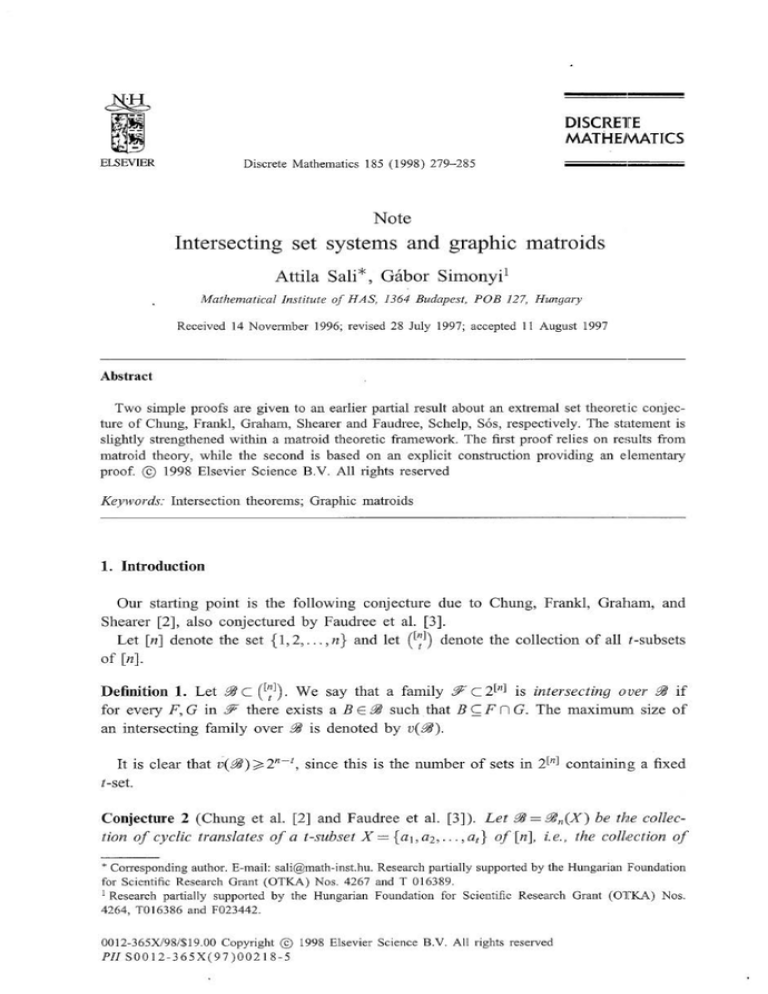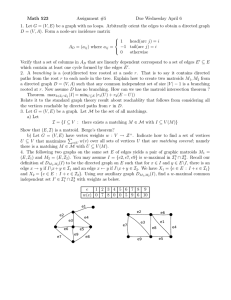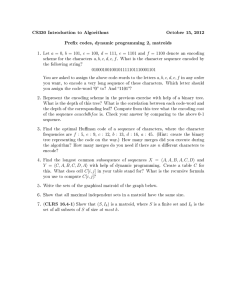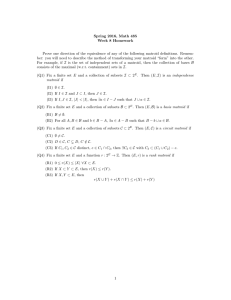
DJSCRElrE
MATHEJ\1\ATICS
ELSEVIER
Discrete Mathematics 185 (1998) 279-285
Note
Intersecting set systems and graphic matroids
Attila Sali*, Gabor Simonyi 1
Mathematical institute of HAS, 1364 Budapest, POB 127, Hung(lry
Received 14 Novennber 1996; revised 28 July 1997; accepted I l August 1997
Abstract
Two simple proofs are given to an earlier partial result about an extremal set theoretic conjecture of Chung, Frank!, Graham, Shearer and Faudree, Schelp, S6s, respectively. The statement is
slightly strengthened within a matroid theoretic framework. The first proof re lies on results from
matroid theory, while the second is based on an explicit constJuction providing an elementary
proof. @ 1998 Elsevier Science B.V. All rights reserved
Keywords: Intersection theorems; Graphic matroids
1. Introduction
Our starting point is the following conjecture due to Chung, Frank!, Graham, and
Shearer (2), also conjectured by Faudree et al. (3].
Let [n] denote the set {1,2, ... ,n} and let (l';') denote the collection of all t-subsets
of [n].
Definition 1. Let £!4 c ([;1). We say that a family !F c 2[n] is intersecting over Pl if
for every F, G in !F there exists a B E Pl such that B ~ F n G. The maximum size of
an intersecting family over £!4 is denoted by v(Pl).
It is clear that v(£!4);;?: 2n-l' since this is the number of sets in 2[n] contajning a fixed
t-set.
Conjecture 2 (Chung et al. [2] and Faudree et al. [3]). Let £!4 = f!JJn(X) be the collection of cyclic translates of a t-subset X= {a 1,a2 , •.. ,a1 } of[n], i.e. , the coll.ection of
• Corresponding author. E-mail: sali@math-inst. hu. Research pa1t ially supported by the Hungarian Foundation
for Scientific Research Grant (OTKA) Nos. 4267 and T 016389.
1 Researcb partially supported by the Hungarian Foundation for Scientific Research Graut (OlfKA) Nos.
4264, TO I6386 and F023442.
0012-365Xf98/$ 19.00 Copyright @ 1998 Elsevier Science S.V. All rights reserved
Pll SOO 12-36 SX(97 )002 I 8 - 5
280
A. Sali, G. Simonyi I Discrete Mathematics 185 ( 1998) 279-285
t-sets of form X+ i = { a 1 + i, a2 + i, ... , at+ i}, where the addition is intended modulo
n. Then
Graham has offered $100 for a proof of this conjecture [5]. It was shown to be
true for arbitrary X when t = 1, 2, furthermore for the particular (consecutive) set
X={l,2, ... ,t} with arbitrary t by Chung et al. [2], also by Faudree et al. [3] and
later by Griggs and Walker, too [6]. The case t = 3 and X arbitrary was also proven,
see [4].
Griggs and Walker [6] used the observation that v(go) is equal to the conjectured
value provided there exists a suitable partition of 2[n] into 2n-t classes such that intersection of two subsets from the same class does not contain any member of go.
They call such a partition class an anti-cluster for go. They show that a partition of
2[n] into 2n-t anti-clusters for go exists provided a t x n (0, 1)-matrix exists with the
property that for every B E go the columns indexed by the elements of B are linearly
independent over GF(2). That is, though they did not formulate this way, they proved
the following theorem.
Theorem 3 (Griggs and Walker [6]). Let go be a collection oft-subsets of [n]. If a
binary matroid At of rank t exists such that every member of go is a base of At,
then v(go) = 2n-t.
Griggs and Walker proved that for the consecutive case a suitable (0,1)-matrix exists,
hence by Theorem 3 the conjecture holds. They also observed that for arbitrary X there
exists a suitable matrix for the ordinary (i.e., not cyclic) translates of X.
In the present note we show that if go is the collection of cyclic translates of the
consecutive t-set, then there exists a graphic matroid At, such that all members of go
are bases of At. This strengthens Griggs and Walker's result by the well known fact
that every graphic matroid is binary, but not all binary matroids are graphic.
We will assume some familiarity with matroid theory throughout the paper. For
definitions and basic theorems one may consult Welsh's book [8].
2. The constructions
In this section we present two constructions of graphic matroids so that cyclic translates of a consecutive t-subset X of [n] are all included amongst the bases.
The first construction remains implicit by using existing results from matroid theory.
The second one is explicit and completely elementary. We start by formalizing the
statement.
Theorem 4. Let go= gon(X) be the collection of cyclic translates of X= { 1, 2, ... , t }.
Then there exists a graphic matroid At such that all members of go are bases of At.
A. Sali, G. Simonyil Discrete Mathematics 185 ( 1998) 279-285
2
3
4
5
6
7
8
281
10
9
E(10,6)
2
3
4
5
6
Fig. 1.
Our first proof is based on the following theorem of Edmonds (unpublished, see [ 1])
and a theorem of Sousa and Welsh [7].
Theorem 5 (Edmonds [1]). A transversal matroid is binary
iff it possesses
a presen-
tation by a forest.
Theorem 6 (Sousa and Welsh [7] ). A transversal matroid is binary
iff it
is graphic.
The following definition is also needed.
Definition 7. Let n and t be natural numbers with t ~n. The Euclidean bipartite graph
E(n,t) with parameters nand t is defined recursively. Let n=st+r, where O~r<t.
E(n, t) has color classes lA I= n and IBI = t, A= { a1, a2, ... , an} and B = {b1, b2, ... , bt}.
The edge set of E(n,t) consists of the matchings {(bi,ait+I),(b2,ait+2), ... ,(bt,a(i+I)t)}
for i = 0, 1, ... , s - 1, together with the edge set of E( t, r) put on the vertex set
B U { ast+I, ast+2, ... , ast+r }. If r = 0, then E(n, t) consists only of the matchings.
The name of E(n, t) is explained by the construction imitating the Euclidean
Algorithm on n and t. E(lO, 6) is shown in Fig. 1.
The two most important properties of E(n, t) are collected in the next two lemmas.
Lemma 8. E(n, t) is a forest.
Proof. We use induction. By removing the degree one vertices {a1, a2, ... , ast} and
the edges incident to them, the remaining graph is E(t, r) (or a set of independent
vertices), and by induction that is a forest, so E( n, t) is a forest, as well. D
Lemma 9. Let T be a cyclically consecutive t -subset of A, i.e., T = { ai, ai+ 1, ... ,
ai+t-I} where the additions are taken modulo n. Then T can be matched into B.
282
A. Sali, G. Simonyi! Discrete Mathematics 185 ( 1998) 279-285
Proof. The statement is true fori~ (s-1) t+ 1, by definition. If (s-1) t+ 1 < i ~n+ 1-t,
then by the construction the edges {(bl,ast+l),(b2,ast+2), ... ,(br,a11 ) } are all contained
in E( n, t ), so a matching of T onto B can easily be constructed.
If n+ 1-t < i, then T can be written for some 1 ~j <Tin the form T = {a 1, a2 , ... , a1,
an-t+J+I, ... , a 11 }. We use induction on n + t to conclude, applying the induction hypothesis to E(t, r ), that every modulo t cyclically consecutive r subset of B can be
matched to {ast+I,ast+2, ... ,a11 } . In other words, {ast+I,ast+2, ... ,a11 } can be matched
to any cyclically consecutive r-set of B. { a 1 , a2 , ... , a1} are of degree one, thus they
have to be matched to {b1, ... , b1} If t- j>r, then {an-t+J+l, ... , a11 _r} are matched
onto {b;+r+J, ... ,bt} by the construction of E(n,t), and by the induction hypothesis,
the last r vertices of A can be matched onto the consecutive set {bJ+ 1 , ... , bJ+r}.
On the other hand, if r?: t - j, the only thing to show is that the last t - j points
of A can be matched onto the last t - j vertices of B. The induction hypothesis on
E(t,r) yields that {ast+I,ast+2, ... ,a11 } can be matched onto the cyclically consecutive
r set {bJ, ... ,br-t+J,bJ+I, ... ,bt}. However, none of {an-t+J+J, ... ,a11 } is connected to
any of {b 1 , ... ,br-t+J} (recall that b 1,b2, ... ,br are of degree one in E(t,r)), thus the
matching above must match the last t - j points of A onto the last t - j vertices
of B. D
First Proof of Theorem 4. We claim that the transversal matroid defined by E(n, t)
satisfies the requirements. Indeed, all cyclic translates of X= { 1, 2, ... , t} are bases by
Lemma 9. Since E(n, t) is a forest by Lemma 8, Theorems 5 and 6 imply that its
transversal matroid is graphic. D
Now we give a second proof of Theorem 4. This proof explicitly constructs a graph
defining the graphic matroid we need. The construction is completely elementary and
easy to check. Its main merit, we think, is the finding of the graph.
Second Proof of Theorem 4. Let n = at + k with 0 ~ k < t. We construct a simple
graph G oft+ 1 vertices and t+k edges, numbered 1,2, . .. ,t,t+ 1, ... ,t+k. We color
the elements of [n] with 1, 2, ... , t, t + 1, ... , t + k. The collection of elements of co1or i
will conespond to a set of parallel edges in place of the edge numbered i in our graph
thus defining the graphic matroid.
Let the color of an element j E [n] be its remainder modulo t, except for those
divisible by t where we write t instead of 0. This rule is for 1 ~j ~at, the remaining
k elements of [n] will be colored by t + 1, t + 2, ... , t + k, respectively. It is immediate
that any two elements that are contained in some consecutive t-block receive distinct
colors.
Now we construct our graph G. Let g.c.d.(k, t) =d.
Let the ve1iices of G be v0 , v1, ... , Vt that form a path. The edges of the path are
numbered with numbers from [t]. Denoting the number of edge vivJ by c( vivJ ), we
stmi with c(v 0v1 ) = d, then increase the number by k mod(t) as long as it does not
A. Sali, G. Simonyi/ Discrete Mathematics 185 (1998) 279-285
283
Fig. 2.
repeat. Then we continue with d - 1, and at the next repetition with d - 2 and so on.
This results in the following pattern:
+ k, d + 2k, ... 'd 1 + k, ... ' 1 + t - k,
d' d
k, d - 1' d - 1 + k, ... ' d - 2, ... ' ... 1'
where the numbers are mod(t).
The vertex vi is called an overflow point if i=t, or i:::;;t and c(vi-Ivi)>c(vivi+I).
The remaining k edges of G, that is those not contained in the previous path, will be
all of the form v0 vi where vi is an overflow point. Now we have to label these new
edges by the numbers t + 1, t + 2, ... , t + k. The number of edge· vo vi is defined as
follows. If c( vi-I vi)= ex, then t + k ?:- c( vovi) + k > t. Now define c( vovi) to be k + ex.
By the previous inequality this value is indeed in the required range of numbers.
All "overflow edges" receive pairwise different numbers, because the edges of the path
receive mutually distinct numbers. There are k overflow points, because they occur
exactly after the edges numbered t - k + 1, t - k + 2, ... , t.
Thus we have proved the following:
Claim 1. There are k overflow points and the edges connecting them to v0 all get
different numbers listing t + 1, t + 2, ... , t + k.
We show an example for G when n = 10 and t = 6 in Fig. 2.
By this point we have already given our construction completely. What is left to
show that it works. The graph has t + 1 vertices, and it is connected, so any spanning
tree (a basis of its cycle matroid) consists oft edges (elements). First observe that any
consecutive cyclic translate U of X corresponds to the edges of the path according to
the numbering, provided U does not contain any of at+ 1, ... , at+ k. The coloring of
those t-subsets that contain some of these elements matches some consecutive t-set of
the following sequence that we call the joining sequence:
1, 2, ... 't, t
+ 1, ... ' t + k, 1, 2, ... 't.
Now we have to show that consecutive t-subsets of the joining-sequence also correspond to cycle-free subgraphs of G. The following observation will be useful. Let
284
A. Sali, G. Simonyi I Discrete Mathematics 185 ( 1998) 279-285
c(vovi)=t+s, c(vi-lvi)=ex and c(vivi+l)=f3. Then t+s=ex+k and f3=ex+k-t or
f3 = ex + k - t - 1. This implies the following:
Claim 2. The ex on the right part of the joining sequence cannot be in a consecutive
t-block of the joining sequence together with t + s. Similarly, the f3 on the left part
cannot be in the same consecutive t-block as t + s.
We say that a subset Z of the joining sequence covers a set of edges of G if the set
of numbers of the edges is a subset of Z. It is immediate that any cycle of G contains
at least one overflow edge vovi. Suppose, that a consecutive t-block covers a cycle of
G. If the cycle contains at least two overflow edges, say v0 vi and v0 v1, with i <j, then
according to Claim 2, the consecutive t-block must contain c(vivi+l) = f3 from the right
part of the joining sequence, while c( v1_ 1v1 ) =ex from the left part. Thus, there are
adjacent edges on the vivJ arc of the cycle, such that the first one's number is contained
from the right, and the next one's from the left part. (This already excludes the case
j = i + 1.) However, their difference is k or k - 1 mod t, therefore their distance in the
joining sequence is at least t, so they cannot be in a consecutive t-block. If the cycle
contains only one overflow edge v0 vi of number t + s, then by Claim 2 the consecutive
t-block must contain ex= c( vi-l vi) on the left part of the joining sequence. If there is
an edge on the v0 vi arc of the cycle whose number is contained from the right part
of the joining sequence, then there is an adjacent pair of edges so that their number
is contained from different parts of the joining sequence in the same order as before
that leads to a contradiction in the same way, as above. On the other hand, if all
edge numbers of arc v0 vi are from the left part of the joining sequence, then we show
there must be some r :::;; s among them. This will be enough for a contradiction since
such an r from the left part cannot be together with t + s in a consecutive t-sequence.
By the definition of the numbering of overflow edges t + s is congruent ex mod d
and so by k and t being multiples of d we must have some number r on the
v0 vi arc that is congruent s mod d for which r :::;; s and we are done. Thus, we have
proved:
Claim 3. Edges of a cycle of G cannot be covered by a consecutive t-block of the
joining sequence.
This last Claim proves that our construction has the required property.
D
3. Conclusion
Two constructions were given for the same problem. It is natural to ask whether
they result in the same matroid or not. It is not too hard to see that, in general, they
are different. Indeed, for the n = 10, t = 6 case the first construction gives a matroid,
which contains four cycles of size three ({1,5, 7},{2,6,8},{3,5,9} and {4,6, 10}),
A. Sali, G. Simonyi/ Discrete Mathematics 185 (1998) 279-285
285
while the second construction contains three cycles of size three ( {2, 6, 10}, {4, 8, 10}
and {3, 7, 9}).
On the other hand, by a theorem of Bondy [1], the graphic matroid of the second
construction is also transversal.
One would hope that explicit constructions may help to prove some new special
cases of Conjecture 2. Unfortunately, we did not succeed in this so far. A problem
to be handled is that for the non-consecutive case the resulting matroid cannot always
be graphic. Indeed, already for t = 3 and n = 7 one may need Fano's matroid (cf. also
[4] ), which is an excluded minor for graphic matroids.
References
[1] J.A. Bondy, Transversal matroids, base-orderable matroids, and graphs, Quart. J. Math. (Oxford) 23
(1972) 81-89.
[2] F.R.K. Chung, P. Frankl, R. Graham, J.B. Shearer, Some intersection theorems for ordered sets and
graphs, J. Combin. Theory Ser. A 48 (1986) 23-37.
[3] R. Faudree, R. Schelp, V.T. S6s, Some intersection theorems on two-valued functions, Combinatorica "6
(1986) 327-333.
[4] Z. Fiiredi, J.R. Griggs, R. Holzman, D.J. Kleitman, Representations of families of triples over GF(2), J.
Combin. Theoty Ser. A 53 (1990) 306-315.
[5] R.L.Graham, Intersection theorems, Lecture in "First Japan Conference on Graph Theory and
Applications", Hakone, Japan, 1986.
[6] J.R. Griggs, J.W. Walker, Anticlusters and intersecting families of subsets, J. Combin. Theory Ser. A 51
(1989) 90-103.
[7] J. de Sousa, D.J.A. Welsh, A characterization of binary transversal structures, J. Math. Anal. Appl. 40
(1972) 55-59.
[8] D.J.A. Welsh, Matroid Theory, LMS Monographs Series, Academic Press, London, 1976.






